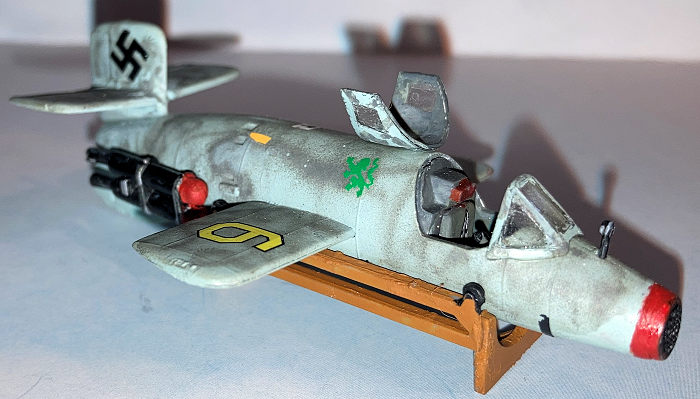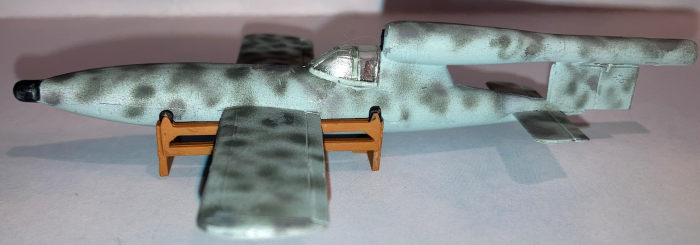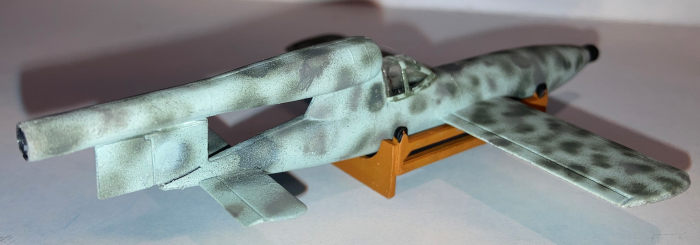
Encore 1/72 Ba-349 & Fi-103R
| KIT #: | 1001 |
| PRICE: | $15.00 'used' |
| DECALS: | One option each |
| REVIEWER: | Joe Essid |
| NOTES: | Reboxed Heller kit |

| HISTORY |
I previewed this reboxed Heller kit here . These two very strange aircraft, neither used operationally, say a great deal about Germany's last-ditch efforts to stop the Allied bomber offensive.
The more I learn about that stage of the European war, the more I need to learn, but that's the core of learning, isn't it? Now for a what-if:
"Hauptmann. We need a decision. One of you WILL fly the Reichenberg." The Group Captain, like some stock villain in a prewar film, had an obligatory riding crop, monocle, and saber-scar. "Jawohl Herr Oberst! Hans, you flip it." Willi passed the war-souvenir Pound coin, acquired from the pilot of a downed Hurricane after Dunkirk in very different time, to his squadron mate.
 Hans
looked like he had sucked a lemon, as he studied the aircraft in the cavern. The
nearby one was a Bachem Natter smaller than the captured Renault he'd used
around the old French airbase, back when he and Willi flew 109s and earned that
Pound coin.
Hans
looked like he had sucked a lemon, as he studied the aircraft in the cavern. The
nearby one was a Bachem Natter smaller than the captured Renault he'd used
around the old French airbase, back when he and Willi flew 109s and earned that
Pound coin.
The Reich's new interceptor appeared as mean as it was small; Yellow 16 had proven herself a lucky ship. She's been the first to shoot down a B-29 and have her pilot survive the encounter. She'd also been the first Natter fitted with the new parachute, so the wooden tail section could be recovered intact for reuse, unless it hit a tree coming down. She'd completed three missions. One of her pilots was still alive, in hospital.
Then, Hans considered the Fi-103R "Reichenberg," on a wooden frame and ready to be slung under an Do-217. He'd prefer flying that lumbering bomber into a squadron of Thunderbolts, since the Fieseler was not an aircraft to him at all, but a guided missile. It didn't even have markings. He thought of the kamikazes that had hit the Americans at Leyte, when MacArthur's invasion force got decimated in exchange for most of Japan's surviving capital ships. Better to put a camera in the nose and fly it like some of the new remote bombs.
Live to fight again, as he and Willi had always done. They'd escorted bombers to London, run jabo missions at Kursk, defied Mustangs over Berlin. Most of their old squadron mates were prisoners of war or dead. Yet now, this humiliation, transferred to a program run by the strutting SS fanatics. At least the food was decent.
Hans pondered the two aircraft as the Oberst played with his riding crop. Japan's decisive wave of suicide attacks at Leyte had briefly refocused the war there and away from the air-war over Germany. Yet in time, the B-29s came. First Tokyo burned end to end, then Berlin from the super-bombers.
The higher-ups saw a last-ditch chance, especially after Stalin's death and the upheaval among the Soviets, now glowering in their tanks along the Vistula, as political killings escalated in Moscow while Warsaw got pulverized a third time in the war.
New wonder-weapons, many of them more dangerous to friend than foe, appeared monthly from the engineers' drafting tables. If LeMay's Superfortresses could be stopped. . .
 "Come
now, gentlemen," The Oberst sneered. "You both are fully trained in each
aircraft, and the Reichenberg has our best ejection seat. You both have ridden
it safely out of the trainers. In any case, orders are orders. These arrogant
Americans need a short, sharp lesson. We let our pilots choose their weapon in
this program. When you can't or won't, you flip a coin."
"Come
now, gentlemen," The Oberst sneered. "You both are fully trained in each
aircraft, and the Reichenberg has our best ejection seat. You both have ridden
it safely out of the trainers. In any case, orders are orders. These arrogant
Americans need a short, sharp lesson. We let our pilots choose their weapon in
this program. When you can't or won't, you flip a coin."
Hans looked hard at Willi, who was forcing a smile. "Go ahead, Hans." Hans flipped the Pound into the air.
The base's siren sounded. Even underground they could already feel the deep droning. B-29s. In the cavern they at least were safe, for now. So many rumors about bigger bombs had circulated, even an atomic one, that they had stopped listening to the briefings. Just get us in the air, even if we face British Meteor jets. That had become their motto. Get us in the air, and we'll do the rest.
"Tails" Willi said, while the Pound coin flew and sirens wailed.
| THE KIT |
It provided no surprises, as noted in my preview. Two aircraft are included, each with only a few parts. My plans to move the Natter around began with a 1/72 Hasegawa halftrack to pull a mobile launcher put together from a Mistral trolley and lots of tubing. Later I added an ESCI PZKW II chassis to tow the contraption from underground bunkers. I'll feature the launcher, in all its Rube-Goldberg craziness, in a future review.
| CONSTRUCTION |
You would think that a kit with so few parts would mean easy work. I found otherwise, though there's nothing that a skilled hand with CA, putty, and sandpaper cannot sort out.
In an hour's time, I had
both kits together. The stabilizers on the Natter have no mounting tabs, so
getting their angles correct meant using jigs. I broke them off a few times,
too. I'd recommend setting a rod
 through
the fuselage and then embedding it in each stabilizer for a secure bond. Very
late in the build I broke one off yet again, which meant setting that pin and
retouching the paint job. So I then removed the other for the same treatment.
Learn from my foolishness: save yourself trouble and set pins early.
through
the fuselage and then embedding it in each stabilizer for a secure bond. Very
late in the build I broke one off yet again, which meant setting that pin and
retouching the paint job. So I then removed the other for the same treatment.
Learn from my foolishness: save yourself trouble and set pins early.
The Fi-103R posed no such issues.
After wiping each kit with rubbing alcohol, a shot of white Mission primer showed me several spots where I had to fill and sand, which I did mostly with thick CA glue and a few dabs of Tamiya putty. The lower-wing joint on the Fi-103R provided the worst fit and took the most time to correct. The builder had best bring patience to the table.
The small size of each aircraft meant careful maneuvering with thin sanding sticks, but the work proceeded quickly. I held off on the Natter's solid-fuel rockets as I considered what colors to paint them. After work with primer and putty, I had no misfitting parts. Then the fun began.
| COLORS & MARKINGS |
First I washed with black up the minimalistic interiors, which I'd pre-painted before assembly with vintage Humbrol RLM gray. This tin sat in a nostalgic stash of my pre-teen 1970s enamels. I tell you, they don't make paint like that today. Like Proust smelling something that carried him back in time, the scent of vintage Humbrol transported me to my builds of the 1970s. If the tinlets get closed properly with clean lids, and you stir things up with a toothpick before painting, they brush on smoothly with a good brush and still dry flat after half a century. No modern enamel does that for me.
I airbrush only with acrylics, and I wanted to test Luftwaffe mottling and lines with the fine needle for my Badger Patriot airbrush. I began with Vallejo Air's light blue for the overall color, then mottled the Fi-103R with a their RLM gray-green. To add some variety (Hans and Willi live in a what-if world) I used extra RLM Gray-violet mottles to vary the paint scheme. The effect looks striking on a tiny kit.
 Natter
camo likely would have served as much to disguise the rocket-plane on the
ground, and I toyed with the idea of painting it to match the halftrack. In the
end, I went with something similar to Encore's conjectural markings for an
operational Natter, using a few of the kit decals. The Natter's hasty-looking
gray-violet "squiggles" actually proved far harder to get right. I had to touch
up several areas with blue and try, try again. With pressure right on the
compressor, a clean airbrush, and a light touch, I began to get very fine lines
at close distances.
Natter
camo likely would have served as much to disguise the rocket-plane on the
ground, and I toyed with the idea of painting it to match the halftrack. In the
end, I went with something similar to Encore's conjectural markings for an
operational Natter, using a few of the kit decals. The Natter's hasty-looking
gray-violet "squiggles" actually proved far harder to get right. I had to touch
up several areas with blue and try, try again. With pressure right on the
compressor, a clean airbrush, and a light touch, I began to get very fine lines
at close distances.
I elected not to paint this operational "Yellow 16" black on the bottom. What difference would that make, really, for something hurtling toward bombers at 600 miles per hour? Even clear shellac on the Natter's plywood would have been just fine, and I've seen a whiffer online done that way.
For the Fi-103R with a far lower top speed, camo would help against escort fighters, but there'd be no markings for a one-and-done aircraft. I didn't even bother to find stencils in my decal dungeon. I also omitted Balkenkreuz on the Natter's wings and instead grabbed numbers from a KP Yak-23 jet. My consideration? Early operational Natters with new features such as better parachutes for the tail might have been weaponized prototypes, thus retaining prototype numbers. I added the T-Stoff decal from the kit's sheet (oddly, no C-Stoff decals are included) as well as some random markings, including a rampant green lion from old Armory heraldry decals meant for wargaming figures. Both kits have tiny seat belt decals. They went down great, after some Micro-Set to secure them.
Everything got topcoats of Tamiya flat, after the Natter had its decals. The little wooden stands were a cause for more nostalgia, in the form of square-bottle Testors flat brown from the 70s. It did not dry flat but looked good, so I hit the stands with Tamiya flat.
Having boogered up the Natter's instrument panel I elected to print a paper panel using an image I found online, showing a conjectural layout for an operational Natter. I glued it to cardstock and filled the nose with a blob of Handi-Tak putty, to give the dash something to stick to, there being nowhere to glue the part securely.
 The
Natter's strap-on solid-fuel rockets got painted Tamiya metallic gray with the
front of each rocket in Tamiya red. I masked the front of the Natter's nose and
brushed that red, as well. The nose-cone (shipped in clear) got the same red. No
one seems to know what color the part would have been on an operational Natter.
I'm guessing "no part" at all during launch, a cover being more useful when
moving the aircraft on the ground but in the air, because "Don't bump the
rockets, you idiot!." That cover would otherwise become one more item on a
pilot's hasty checklist in combat after (if) he recovered from a black-out
during lift-off.
The
Natter's strap-on solid-fuel rockets got painted Tamiya metallic gray with the
front of each rocket in Tamiya red. I masked the front of the Natter's nose and
brushed that red, as well. The nose-cone (shipped in clear) got the same red. No
one seems to know what color the part would have been on an operational Natter.
I'm guessing "no part" at all during launch, a cover being more useful when
moving the aircraft on the ground but in the air, because "Don't bump the
rockets, you idiot!." That cover would otherwise become one more item on a
pilot's hasty checklist in combat after (if) he recovered from a black-out
during lift-off.
The cover will be posed with tools and other parts for the launcher when I get to that part of the finished diorama. I even have a busybody engineer figure, briefcase in hand, for that scene.
The Natter's canopies got masked and brushed with the Vallejo paints, while I used painted decal-strips for the manned Buzz Bomb. This proved fiddly in the extreme for such tiny framing, and my painted decal paper needed help sticking down; I touched up the frames with Future as a "glue."
Just before shooting photos I saw how the nose panel for the Natter, with its rockets picked out with a Prismacolor silver pencil, still fit with a noticeable seam. That got putty, sanding, and a touch-up. I also added a rocket exhaust nozzle with a bit of brass tube, painted with Testor's Model Master Chrome Silver.
Finally, I sat the two crazy aircraft in their cradles and called this stage of the diorama project done. Any boo-boos revealed by the photos will get their due when I finish the diorama.
| CONCLUSIONS |
I don't do many whiffers, but this one was great fun. Too small and fiddly for a novice, but if treated like a limited-run kit, it is worthwhile to produce two interesting subjects. I knocked both out in about 11 hours of work, mostly painting and detailing them. The pair thus took more effort than I expected for something so tiny, but it could have been worse. I spent more time filling seams on my Condor 1/72 A-36's wing than on the entirely of both Encore kits.
You can find Encore's boxing online for reasonable prices, though it was last issued in the early 2000s. Brengun produces a fine-looking PE and resin launch tower in this scale, but at a price that lies beyond my modeling budget.
| REFERENCES |
Ford, Brian. German Secret Weapons: Blueprint for Mars. New York, Ballantine, 1969.
National Air & Space Museum, "Bachem Ba 349 B-1 Natter (Viper)" https://airandspace.si.edu/collection-objects/bachem-ba-349-b-1-natter-viper/nasm_A19600313000
Wikipedia pages on the Fi-103 and Ba 349A.
25 June 2025
Copyright ModelingMadness.com. All rights
reserved. No reproduction in part or in whole without express permission from
the editor. If you would like your product reviewed fairly and fairly quickly, please contact the editor
or see other details in the
Note to
Contributors. Back to the Main Page
Back to the Review
Index Page
Back to the Previews Index Page